New initiatives in a town that has practiced "Coexistence with Nature" for half a century: Aya, Japan
16.01.2023
SUBMITTING ORGANIZATION
AEON Environmental Foundation
OTHER CONTRIBUTING ORGANIZATIONS
Institute for Global Environmental Strategies (IGES)
DATE OF SUBMISSION
11/01/2023 (This is an updated case study originally submitted on 14/02/2022)
REGION
Asia
COUNTRY
Japan
KEYWORDS
Lucidophyllous forest; Aya project; Corridor; UNESCO Biosphere Reserve; Japanese honeybees
AUTHORS
Hideyuki Kubo, IGES
Yuriko Yamamoto, AEON Environmental Foundation
Nobuki Kawano, Aya Town Office
Summary Sheet
The summary sheet for this case study is available here.
1. Background
When you open the website for Aya Town, you will see the town logo -“Aya Town with lucidophyllous forest.” Aya has been protecting Japan’s largest lucidophyllous forest (evergreen, broadleaf forest with glossy leaves) as well as promoting natural ecological agriculture throughout the town since the late 1960s. That means that the town has already been practicing “harmony with nature,” the 2050 target of the Convention on Biological Diversity (CBD), for half a century. This is due to the conscious efforts of mayors, residents and supporters of Aya, who have reflected on their post-war economic development experiences.
In recent years, Aya Town has taken on a new challenge of protecting its lucidophyllous forest, while at the same time restoring habitat by re-converting part of the cedar plantation to lucidophyllous forest, to create a system that allows a diverse range of people to utilize the forest in a variety of ways, and to demonstrate scientifically that these activities are enhancing the ecological richness of the locality.
Before introducing the new challenge, an explanation should be given as to how Aya Town introduced policies of lucidophyllous forest protection and natural ecological agriculture. Aya was originally a town with a thriving forestry industry (see Figure 1 for the location of Aya). In the 1950s, the population grew to 12,000 at its peak as the logging and clear-cutting of lucidophyllous forests for paper chips flourished and coincided with the construction of the Aya river dam. In the 1960s, with the end of the dam project and the shift to oil as fuel due to the energy revolution, demand for timber plummeted, and the population suddenly declined to the 8,000 level. Mayor Minoru Gouda (in office 1966-1990) described Aya at this time as a “town on the run in the night.”
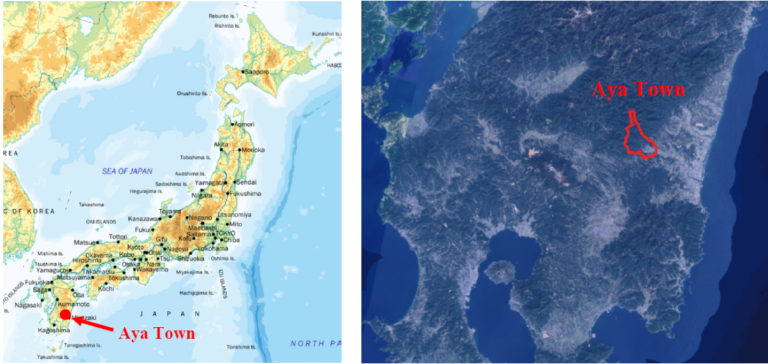
In 1967, a plan to clear-cut a state-owned lucidophyllous forest near farmland at the foot of the nearby mountain came to light. Mayor Gouda, together with the residents who made their living by cutting down the famous lucidophyllous trees such as Japanese torreya and zelkova, vehemently opposed the plan and succeeded in reversing it. According to records, the mayor was considering to convert the national forest land into farmland (mandarin orchard) in order to sustain the economy, rather than clear-cutting for pulpwood, which would only bring temporary prosperity to the economy. However, since the area was not suitable for mandarin oranges, the land was not converted to farmland. Mayor Gouda decided to formulate a basic policy of protecting the lucidophyllous forest and to utilize it as a tourism resource. In 1970, he started a campaign to have the area designated as a quasi-national park.
In fact, Aya has long been blessed with lucidophyllous forest and has produced woodwork, boards, bamboo swords, and other handicrafts. In the late 1960s, Japan was in the midst of rapid economic growth, and people began to gather in Aya to create “genuine” crafts made by hand rather than disposable products. In 1973, they formed a cross-industrial crafts cooperative, with about 300 supporters from inside and outside the prefecture, including prominent scholars, artists, businessmen, politicians, and bureaucrats. In promoting a policy to protect the lucidophyllous forest, Mayor Gouda received advice on the significance of protecting such forests from craftsmen and scholars who had begun working in Aya in the late 1960s. The mayor also carefully studied books on lucidophyllous forest culture that were already available at the time. The local government in Aya Town therefore decided to position its policy for the protection of the lucidophyllous forest not only from the viewpoint of nature conservation, but also as cultural policy to protect the forest that has helped in the development of the town’s history and culture. This was based on ideas that “people cannot live without nature” and “our present-day life was born out of this natural ecosystem.”
In 1973, the local government launched the “Home vegetable garden campaign” to promote household economic self-sufficiency and health through the introduction of natural ecological agriculture and the consumption of safe vegetables. In 1978, the town built the nation’s first facility to supply liquid compost using human waste, and in 1981, it built a facility to compost livestock manure. Then, in 1988, Aya enacted Japan’s first “Ordinance on the Promotion of Natural Ecological Agriculture. “
In Aya, a system of self-governing community centers is still actively functioning today. There are 22 communities and community centers in the town, and each community has its own local performing arts, various events, children’s clubs, and other activities that promote interaction among residents. The community center movement began in 1951, and in 1965, a system of self-governing community centers was established that has continued to the present day. Health promotion and home vegetable gardening have also spread in conjunction with activities of community centers. In his book, “The Spirit of Unity (1998),” Mayor Gouda describes how the modern-day Aya Town is the result of the “community center movement” that awakened the spirit of independence and self-reliance in communities and residents. It has been universally agreed that the development of the community center movement has played a major role in the success of natural ecological agriculture in Aya Town.
2. Lucidophyllous forests in Aya
2.1 Distribution of lucidophyllous forests
Lucidophyllous forests are distributed from western Japan to southern China and the Himalayas (see Figure 2). Originally, it is believed that lucidophyllous forests were widely distributed in the western part of Japan’s archipelago, but today they cover less than 1% of the country’s land area (see Figure 3). Approximately 2,500 hectares of primary lucidophyllous forest remain in Aya, making this one of the largest extant lucidophyllous distributions in Japan.


2.2 Corridor of lucidophyllous forests in Aya
A policy to protect lucidophyllous forests in Aya was adopted after issues surrounding clear-cutting of lucidophyllous forest were solved in 1967. However, the policy was not necessarily applied to state-owned forests in the town. The situation then changed drastically in 2003 when a citizens’ group proposed a green corridor concept, which called for the creation of a corridor of lucidophyllous forests, connecting native lucidophyllous forests scattered around the Miyazaki plain. Kyushu Regional Forest Office, which has jurisdiction over state-owned forests, took notice of this concept and offered to collaborate with the government of Aya Town. As a result, in 2005, Kyushu Regional Forest Office, Miyazaki Prefecture, Aya Town, the nature conservation society of Japan, and the Teruha forest association (NPO) initiated the “Aya river basin lucidophyllous forest protection and restoration plan (Aya lucidophyllous forest project, hereafter referred to as “Aya project”). Under this project, the five parties work together to protect natural lucidophyllous forests and restore habitat by re-converting parts of the planted forests to lucidophyllous forests over a 100-year period to create a green corridor. The target area is Aya Town and four adjacent municipalities, covering an area of approximately 10,000 hectares (see Figure 4).

Figure 5 depicts land use in the target area of the Aya project 100 years from now. At present, lucidophyllous forests are distributed in areas No. 1, 2, 4, and 7 in the figure, indicating that they are fragmented. Areas No. 3, 5, and 6 are mainly cedar plantations, where lucidophyllous forests were cleared in the 1950s and cedar trees were planted in their place. The main objective of the Aya project to restore habitat by re-converting these cedar plantations back to lucidophyllous forests over a period of 100 years. The first step is to thin out the current cedar forest to open up the space and allow more light to enter the forest. This will allow seeds from the surrounding lucidophyllous forest to germinate in forest patches. Subsequently, when these trees have grown sufficiently, the cedars will be cut down and the forest will be restored to a lucidophyllous forest (see Figure 6).
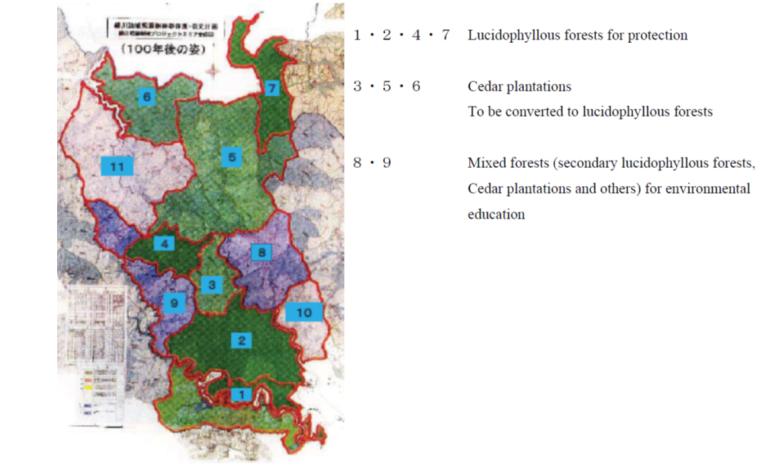
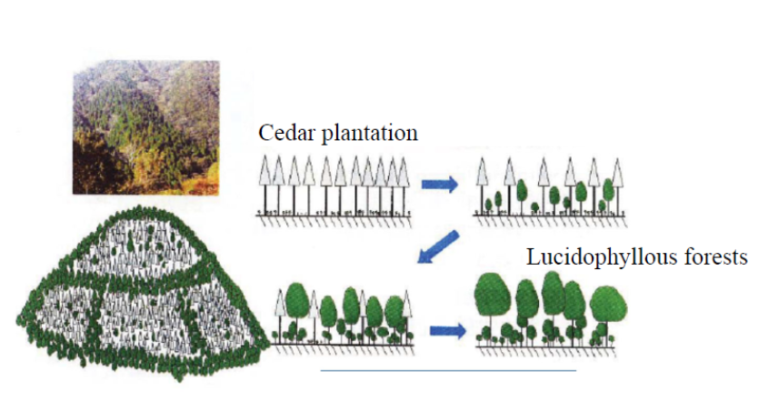
2.3 Designation as a biosphere reserve
In the course of activities of the Aya project, the idea of registering the Aya area as a biosphere reserve under United Nations Educational Scientific and Cultural Organization (UNESCO) began to be discussed around 2008. In September 2011, the Japanese government submitted a recommendation to UNESCO, and in July 2012, the Aya UNESCO Biosphere Reserve was officially designated. In response, the local government set up a section for the promotion of UNESCO Biosphere Reserve in April 2013, which was upgraded to a promotion office in April 2014. In February 2014, Aya Elementary School and Aya Junior High School were registered as UNESCO schools for the promotion of education for sustainable development (ESD).
One of the characteristics of biosphere reserves is that they simultaneously fulfill three functions: biodiversity conservation, socioeconomic development, and support for academic research and education. In Aya, both biodiversity conservation and socioeconomic development have already been addressed over the past 50 years. Therefore, it is important to achieve more results in academic research and education. To this end, the local government signed a comprehensive cooperation agreement with universities in Miyazaki Prefecture. Furthermore, the Aya UNESCO biosphere reserve center was established and under the promotion office, and researchers have been assigned to the center to comprehensively deal with related activities.
2.4 Research work: What turtles and Castanopsis trees teach us
Among the academic research activities that have already begun to show results is the investigation of pond turtles. A pond turtle is a species of turtle endemic to Japan, and is designated as “semi-endangered” on the Red List of Japanese pond turtles by the Ministry of the Environment. Although the turtle was known to inhabit Aya town, the ecology of the species was not well known. Therefore, the local promotion office for the UNESCO biosphere reserve began an ecological survey of pond turtles in cooperation with Miyazaki University in 2016. As a result, it was found that most pond turtles live upstream from the residential area where the town’s office is located, and that they move back and forth between rivers and forests as well as along riverbanks. In some cases, turtles discovered in the North Aya river were subsequently observed in the South Aya river (see Figure 7). On the other hand, it was also found that in the area downstream from the residential area, leatherback turtles and green turtles were abundant, meaning that in the space where humans live, the pond turtles lost their habitat to non-native turtle species. Pond turtles in the upper reaches of the river inhabit the riverbanks and bask in the sun, paying no attention to the food that humans place in traps, and they seem to reign as the masters of the river. By observing the ecology of pond turtles, it can be noted that lucidophyllous forests in the upper reaches of the river have been protected in their natural state.
There is a legend about pond turtles. A short distance upstream on the South Aya river, the Kawanaka shrine is located in the mountains. It is not known when this shrine was founded, but Saiko-ji Temple, which stood on its grounds before the Meiji era, is said to have been founded in the year 717. According to a legend, Buddha was enshrined at Saiko-ji Temple, but when the temple was about to be incinerated due to an order to abolish Buddhism, the Buddha was thrown into the South Aya river to hide it. The Buddha later appeared riding on a pond turtle, and was subsequently hidden in a cave by the people who saw it.
The castanopsis tree, one of the representative tree species of lucidophyllous forests, produces acorns. While a wide variety of insects feed on nutritious acorns in primary forests, a new study has found that some moths lay their eggs on the acorns of trees before they fall. The moth larvae feed on the acorns and grow, and for this reason the production of acorns as seeds is influenced by moth larvae. Although still a work in progress, the study suggests that the acorns from castanopsis trees in Aya town are influenced by moths, and thus the degree of growth varies greatly from tree to tree, resulting in greater diversity and consequently less damage from typhoons and other natural disasters. On the other hand, castanopsis trees in areas unaffected by moths may be more affected by natural disasters. In other words, although at first glance moth larvae may be ruining seeds, their feeding on acorns may actually be strengthening the vitality of castanopsis trees as a whole.
Since the lucidophyllous forest in Aya was designated as a UNESCO biosphere reserve, activities to generate scientific knowledge rooted in the local community have been revitalized, and scientific evidence is beginning to show how the nature of the town has been protected through conservation activities over the past 50 years.
3. Secondary lucidophyllous forest: Creating a new relationship between humans and nature
3.1 Founding AEON’s forest
On November 23, 2013, the first tree-planting ceremony for the creation of the ” AEON Forest in Aya” was held on approximately six hectares of land owned by the town at the foot of a mountain near the town center (see Figure 7). Originally, this area was a cedar plantation managed by the Kyushu Regional Forest Office, but the time had come to cut down the trees. The local government decided to purchase the plantation, construct a new school building for Aya Junior High School using the cedar timber, and restore the site to a lucidophyllous forest. The local government, AEON Environmental Foundation, and Miyazaki Central Forestry Cooperative then signed the “Agreement for maintenance and conservation of AEON forest in Aya” in November 2013 (the government of Miyazaki prefecture joined the agreement in 2022). In the AEON forest, a total of 14,200 trees were planted over a three-year period from 2013 to 2015, two hectares each year. More than 20 species were planted, including yew, oak, castanopsis, chestnut, and mountain cherry. In addition, 5,200 trees were planted from 2017 to 2019, and cherry trees were planted in 2021. A total of more than 2,700 people participated in these tree planting activities (see Figures 8 and 9).



Two main factors can be pointed out as the background to the establishment of a secondary lucidophyllous forest as the AEON forest in Aya. The first is the designation of the area as a UNESCO biosphere reserve. Since one of the functions of the UNESCO biosphere reserve is to boost economic and social development, there is always a need for activities that utilize lucidophyllous forests and link them to the development of the local economy and society. The other is corporate forestation activities launched by Miyazaki Prefecture in 2008. The AEON Environmental Foundation’s involvement with Aya Town was triggered by the prefectural government’s corporate forestation activities. Moreover, AEON Environmental Foundation has been conducting tree planting activities in Japan and overseas using local species and this has led to reforestation activities for a secondary lucidophyllous forest.
In addition to this, it was hoped that the AEON forest would provide more opportunities for local children to have direct contact with lucidophyllous forests. As part of its activities, the Aya project conducted a “Survey on important areas for human-nature interaction” in 2013, targeting fourth-grade students and above in Aya. As a result, a large number of adults responded that lucidophyllous forests were important areas, but areas considered important by elementary and junior high school students were limited to their living areas, with no responses indicating that mountains were important. Therefore, it was also desirable to create a new lucidophyllous forest that children can directly relate to, in places that are easily accessible to them. The UNESCO biosphere reserve promotion office then considered the following ideas for the specific role that the AEON forest could play. Some of them have already been put into practice:
- Biological and ecological diversity
- Natural ecological agriculture (bees, fruits, vegetables, etc.)
- Forestry (mainly special forest products)
- Crafts (woodwork, dyeing and weaving, glazes, etc.)
- Food and medicine (wild plants, folk medicinal herbs, etc.)
- Renewable energy (wood and charcoal)
- Environmental maintenance (CO2, conservation, soil improvement, etc.)
- Education (various types of environmental education)
- Comfortable environment (natural gardens, tourism, etc.)
- Utilization of local culture (collaboration with various facilities, local cuisine, events)
- Wellness (self-sustaining, recycling-oriented satoyama community created by synergistic effects)
The next section outlines the activities related to honey bees, natural gardens, and education, which have already produced concrete results.
3.2 Production of local citrus utilizing honey bees
At the foot of the hills where the AEON forest is located, a variety of citrus fruits are grown, including Hyuganatsu (Japanese brand name of Citrus tamurana), a local specialty of Aya Town (hereinafter, local citrus). Furthermore, the plateau that extends from there toward the center of the town is a field crop area where natural ecological agriculture is practiced (see Figure 10).
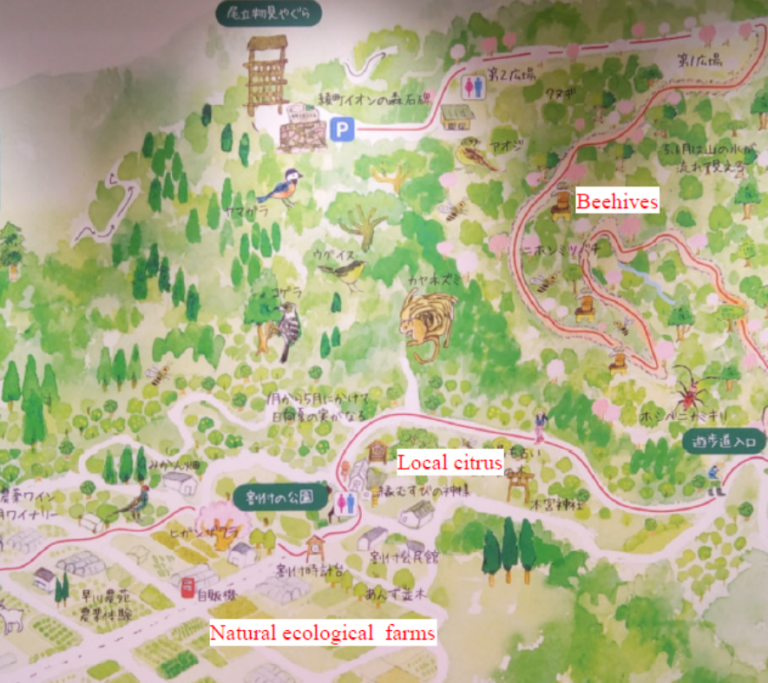
This local citrus, namely Hyuganatsu, requires pollen from different varieties of citrus fruits in order to bear fruit, and Japanese honeybees are the main pollen carriers. Therefore, growing broadleaf trees, including flowering trees, in forests can attract Japanese honeybees. In addition, natural ecological agriculture practiced on the plateau creates a better pollination environment for local citrus, as they are not harmed by pesticides and insecticides. In fact, a study was conducted by Miyazaki University and the government of Aya town on the number of Japanese honeybees visiting local citrus flowers and this revealed that the number of bees visiting the flowers was higher in areas with many natural forests and organic fields. Pollination of local citrus trees has been done manually so far, but if pollination by honeybees increases, agricultural work can be made more efficient. In addition, the Aya project activities and promotion of natural ecological agriculture help to conserve the local ecosystem and contribute to the production of local citrus through natural pollination by Japanese honeybees. This will enable Aya town’s local citrus to be branded as produce from a rich ecosystem.
In addition, one of the farmers growing local citrus at the foot of the AEON forest has installed about 20 beehives in the forest and is experimenting with honey production. In the third year of the trial, about half of the hives have been colonized by bees, and sufficient honey can be collected from three of the boxes (see Figures 11 and 12).

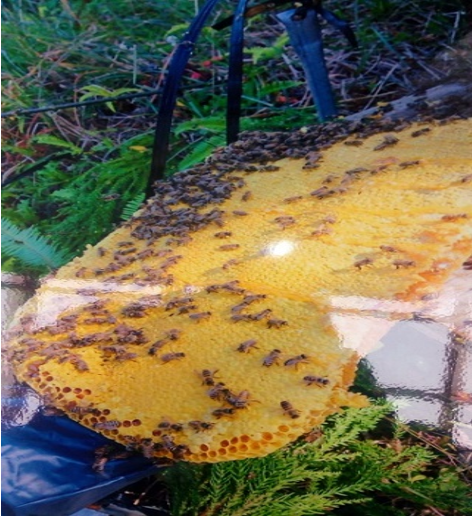
3.3 AEON forest and natural garden connected by Japanese honeybees
Having found that the AEON forest attracts honeybees and is having a positive effect on the cultivation of local citrus, the town’s promotion office has started to improve the surrounding environment by creating a natural garden from the foot of the AEON forest to the center of the town. Residents in Aya have long been involved in a community center activity to create flowerbeds throughout the town, planted with annual flowers. In this new initiative, the promotion office considered planting perennial plants that are closer to the natural ecosystem in the town, so that flowers would bloom every season. By arranging natural ecosystems in a stepping-stone fashion, the aim is to create a natural state not only in backcountry lucidophyllous forests, but also in areas of the town where people live and work (see Figures 13 and 14).


3.4 Education in Aya junior high school
Aya junior high school, a UNESCO school, provides students with many opportunities to think about the relationship between nature and people in educational activities through cooperation with the town’s biosphere reserve promotion office. As part of these activities, first-year students have been measuring carbon accumulation in the AEON forest every year under the theme of “Inquiry into Nature.” For 2020, experts were invited to teach students learned about a remote sensing measurement method and a direct measurement method on the ground. The students then had a field trip into the AEON forest where they measured tree species, including height and diameter for 94 planted trees. A tablet was used to input data. Prior to this measuring work, experts had used a drone to identify 174 planted trees and estimate their carbon stocks. This estimate was then revised using data entered by students to calculate a more accurate carbon stockpile. The revised information was shared with students, namely that these 174 planted trees have accumulated the carbon equivalent of 5.45 million plastic bags. Through this experience, the students learned a series of interrelated matters: Aya junior high school building is constructed of cedar wood; lucidophyllous trees are planted in the area as AEON forest; carbon is stored in this forest; and this is being measured using cutting-edge science and technology (see Figures 15 and 16).

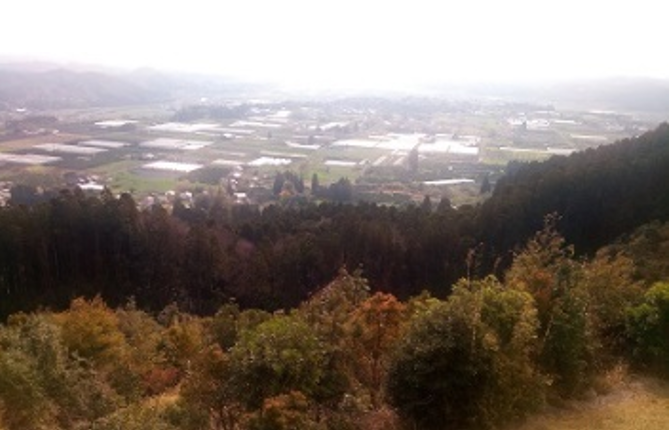
4. Looking to the future
Efforts in Aya over the past half century to coexist with nature have been based on collaboration with a diverse range of people and organizations, not only locally but also from all over Japan and abroad. Activities leading up to the present day were triggered by opposition to a deforestation plan in a state-owned forest, but since then, the national government, the prefecture, the town, and NPOs have worked together to establish the Aya project, and with leverage from an international organization, the entire community has worked to protect and conserve the area as a biosphere reserve. Meanwhile, Aya Town has been working to promote natural ecological agriculture, which has led to Aya-brand agricultural products. The town is now attempting to connect people and nature by creating natural ecosystem in spaces where people live, with the AEON forest at its core. The AEON forest is enriching biodiversity and ecosystems, and at the same time, is enabling people to directly enjoy this abundant biodiversity and ecosystem in various ways. In the residential area, trials are underway to create a natural ecological space that continues in a stepping-stone fashion from the AEON forest. The local government is working to scientifically evaluate these activities. The elementary and junior high schools are creating opportunities for their students to learn from practices that apply cutting-edge science. A lifestyle in harmony with nature developed by the people of Aya over the past half century is now evolving toward the 22nd century, as the town seeks to further deepen integration of people and nature.
Acknowledgement
We thank Mr. Kozo Kawano, Mr. Nobuki Kawano, Mr. Kunihiro Yuasa, Mr. Takahiro Inoue, Mr. Takeshi Kinoda, Mr. Yoshimitsu Fukuda, Mr. Toyama (Aya Junior High School), Ms. Nakagawa (Aya Junior High School), Mr. Shuji Hashimoto, Mr. Ryuichi Kodama, Mr. Michio Matsui and Mr. Shoichiro Hidaka for their generous cooperation to our study. We also thank the AEON Environmental Foundation for its support in conducting the survey.
References
Aya Biodiversity Council. (2015) Local strategy for biodiversity conservation in Aya.
Digital National Land Information (Ministry of Land, Infrastructure, Transport and Tourism, Japan). https://nlftp.mlit.go.jp/ksj/index.html. Downloaded on 27 August 2022.
Kawano, N. (2022) Activities in Aya Biosphere Reserve. Presented at a meeting held in Aya Town Hall (June 1, 2022).
Kawano, K. (2014) Re-converting Cedar plantations to lucidophyllous forests: Process and Issues. Presented at the 2nd committee meeting on protection forests (August 5, 2014).
Kyushu Regional Forest Office. (2022) Lucidophyllous forests in Aya. https://www.rinya.maff.go.jp/kyusyu/aya/syouyoujyurin.html. (August 28, 2022).
Kyushu Regional Forest Office. (2021) Lucidophyllous forests project in Aya: A protection and recovery plan of Lucidophyllous forests in Aya watershed.
Miyazaki Bunka Honpo (2015) History of community development in Aya Town leading up to the establishment of UNESCO Biosphere Reserve.
Teruha Forest Association (2016) Mountain life nurtured by Lucidophyllous forests.
Yamakita, A. (2021) Can woods from local forests be used for Aya woodwork? Newsletter for Lucidophyllous forests, No.59.

